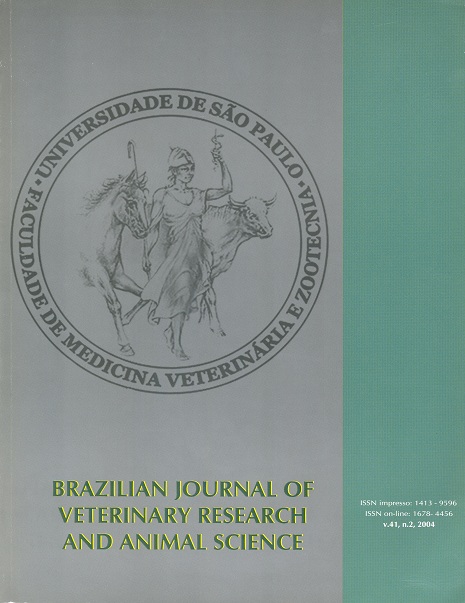Single or double artificial insemination in fixed time in sows with ovulation induced by Luteinizing Hormon
DOI:
https://doi.org/10.1590/S1413-95962004000200008Keywords:
Synchronization, Ovulation, Gonadotrophins, Artificial insemination, SowsAbstract
Two hundred fifty four sows Camborough 22 (PIC®), were divided in 3 treatments: T 1 (n=60) - 600 UI of eCG after weaning and 5 mg of LH, after 72 h, with single artificial insemination (AI) (24 h after LH); T 2 (n=95) - same hormonal treatment of T1, with 2 AI (24 and 32 h after LH); T 3 (n=99) - control group, with 3 AI. The averages of weaning-to-estrus interval (WEI) in T1, T2 and T3 were of 87,4 ± 3,0 (87 - 111), 87 ± 0 (87) and 99,9 ± 13,6 (63 - 135) h, respectively, been reduced (P < 0,0001) by gonadotropins. The duration of estrus (DE) were of 44,3 ± 8,78 (12 - 60), 41,3 ± 9,77 (24 - 60) and 60,1 ± 10,22 (36 - 84) h, respectively for T1, T2 and T3, showed lower (P < 0,0001) in treated sows. Fourteen of 155 sows that received gonadotropins (9,03 %) didn't show oestrus. Among these, 10 return to estrus, denote 40% of the total returns. The diferences in LH to ovulation interval (LH-OV) among control group (56,1 ± 15,91, range: 21 - 93 h) and treated groups (35,7 ± 6,07 in T1 and 35,5 ± 6,06 in T2, range: 30 - 42 h) were significant (P < 0,0001). The litter size (LS) were of 10,6 ± 3,25 (2 - 16) in T1, 11,3 ± 3,0 (4 - 20) in T2 and 11,6 ± 2,74 (4 - 18) in T3, while the same demonstred number of piglets born alive (BA) of 9,6 ± 3,14 (2 - 16), 10,5 ± 2,83 (1 - 18) and 10,5 ± 2,73 (4 - 16). In both TL (P = 0,11) and NV (P = 0,06) there weren't any diference. The farrowing rate (FR) in T1, T2 and T3 were, respectively, 76,67 %, 88,42 % and 91,92 %, been diferent between T1 and T3 (P = 0,01). The gonadotropins were effetive in the ovulation induction and synchronization; the use of 2 AI maintained the reproductive index and, however the single AI do not show significance in LS, there is necessity of new reserchs in this area.Downloads
Download data is not yet available.
Downloads
Published
2004-04-01
Issue
Section
UNDEFINIED
License
The journal content is authorized under the Creative Commons BY-NC-SA license (summary of the license: https://
How to Cite
1.
Candini PH, Moretti A de S, Zanella EL, Silveira PRS da, Viana CHC, Santos I. Single or double artificial insemination in fixed time in sows with ovulation induced by Luteinizing Hormon. Braz. J. Vet. Res. Anim. Sci. [Internet]. 2004 Apr. 1 [cited 2024 Apr. 18];41(2):124-30. Available from: https://www.revistas.usp.br/bjvras/article/view/6267





